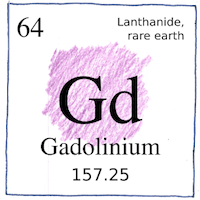Geneva—Jean Charles Galissard de Marignac
elements

|
Gadolinium
Jean Charles Galissard de Marignac found a new spectroscopic line in gadolinite. He had suspected that something yet undiscovered was muddying tests of Mosander’s derivation from cerite. De Marignac separated the new oxide from cerite and named it for gadolinite after Johan Gadolin.
Atomic number 64
Gadolinium make good shielding for nuclear reactors. Small amounts of gadolinium improves the workability of other metals. Gadopentetic acid is given intraveniously as an MRI contrast agent. Green gadolinium phosphors were used for color television tubes. The gadolinium yttrium garnet has various uses in optical equipment. The gadolinium gallium garnet is an imitation diamond. Gadolinium’s magnetocaloric effect makes magnetic refrigerators work. Gadolinium-153 emits gamma rays for testing bone density.
You have no idea
You have no idea what this stuff does. Most people haven’t the vaguest notion. If you’ve never seen it before, if you’ve never heard about it, if you’ve never read about it, then why should you even think of it? On the other hand, what if this stuff were the key to antigravitation? What if it let you save 99% of the energy of sunlight? What if it made a rechargable battery with higher energy density than diesel? Well, you just have no idea.



Gadolinite was named after Johan Gadolin who first isolated yttrium from the mineral.
Gadolinium alloys demonstrate the magnetocaloric effect, whereby they operate in magnetic refrigerators. In a magnetic field, the metal heats up and loses the heat to the environment; when it leaves the field, it cools as its domains grab energy to reorient themselves.
See also in The book of science:
Readings in wikipedia:
Other readings: